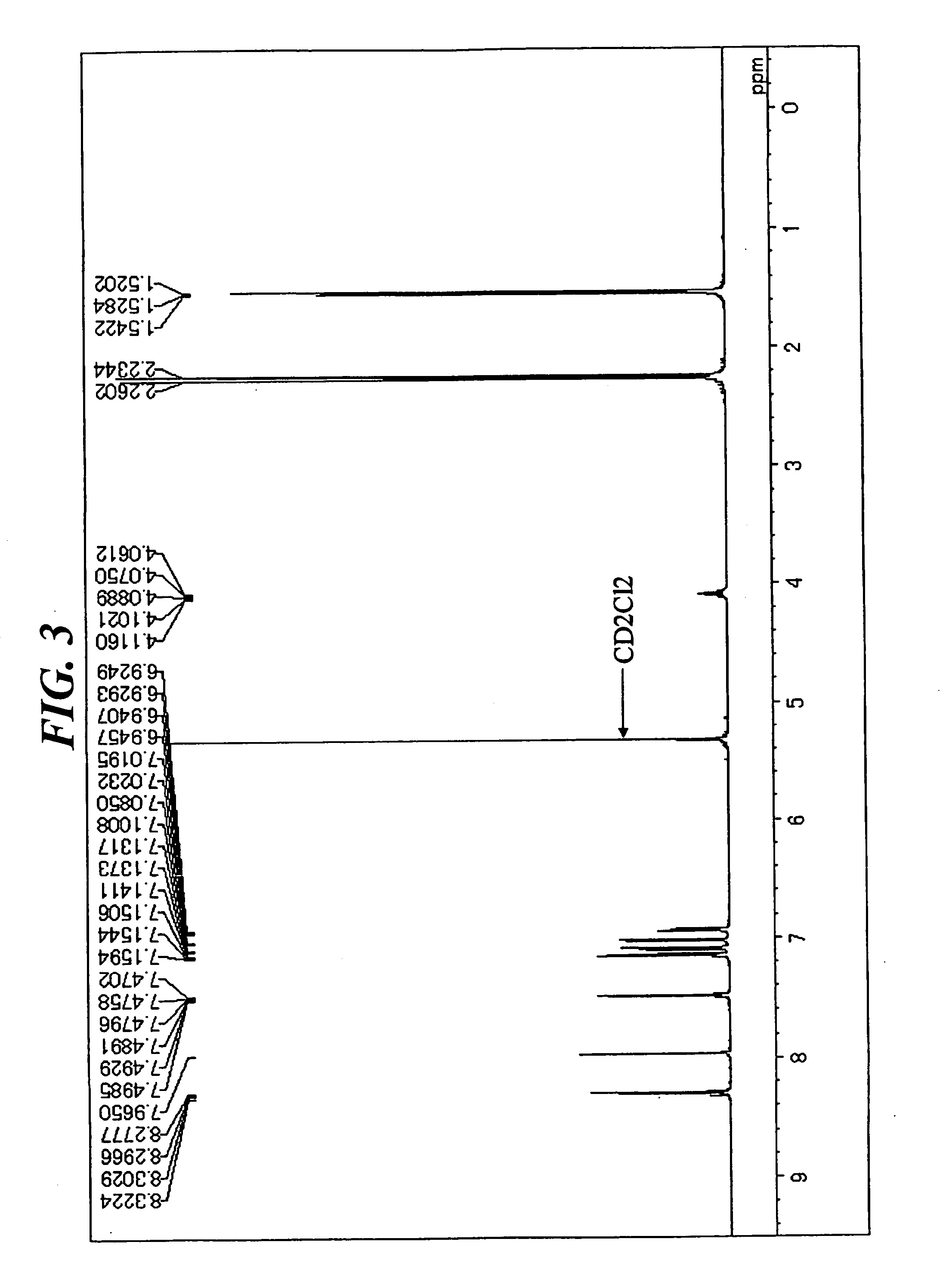Aromatic amine derivative and organic electroluminescence device using the same
a technology of organic electroluminescence and amine, which is applied in the direction of discharge tube luminescnet screen, other domestic articles, natural mineral layered products, etc., can solve the problems of large energy barrier between the transporting layer and the light-emitting layer, difficulty in achieving a luminance high enough to be put into practical use, and inability to achieve a device with a high luminance to achieve the effect of practical use, high emission luminance, and high heat resistan
- Summary
- Abstract
- Description
- Claims
- Application Information
AI Technical Summary
Benefits of technology
Problems solved by technology
Method used
Image
Examples
synthesis example 1
Synthesis of Compound (1)
[0076] In a stream of argon, 5.2 g (14 mmol) of 1,6-dibromopyrene, 10 g (35 mmol) of 4-(diphenylamino)phenyl boronic acid, 0.8 g (0.7 mmol) of tetrakistriphenylphosphine palladium, an aqueous solution containing 7 g (65 mmol) of sodium carbonate in 33 mL of water, and 70 mL of toluene were added to a 300-mL three-necked flask equipped with a cooling pipe, and the whole was refluxed under heat for 8 hours. After the completion of the reaction, a precipitated crystal was filtered out and washed with 50 mL of toluene and 100 mL of methanol. The resultant coarse crystal was recrystallized with toluene, whereby 8 g of a white crystal were obtained. The crystal was identified as Compound (1) through the measurement of a 1H-NMR spectrum (FIG. 1) and a field desorption-mass spectrum (FD-MS) (80% yield). The 1H-NMR spectrum was measured by means of a DRX-500 (a heavy methylene chloride solvent) manufactured by Brucker (the same holds true for the following synthesis...
synthesis example 2
Synthesis of Compound (12)
[0077] In a stream of argon, 5.8 g (13 mmol) of 1,6-diisopropyl-3,8-dibromopyrene, 9 g (31 mmol) of 4-(diphenylamino)phenyl boronic acid, 0.8 g (0.7 mmol) of tetrakistriphenylphosphine palladium, an aqueous solution containing 4 g (65 mmol) of sodium carbonate in 20 mL of water, 30 mL of toluene, and 20 mL of dimethoxyethane were added to a 300-mL three-necked flask equipped with a cooling pipe, and the whole was refluxed under heat for 8 hours. After the completion of the reaction, a precipitated crystal was filtered out and washed with 50 mL of toluene and 100 mL of methanol. The resultant coarse crystal was recrystallized with toluene, whereby 5 g of a white crystal were obtained. The crystal was identified as Compound (12) through the measurement of a 1H-NMR spectrum (FIG. 2) and a FD-MS (80% yield). The maximum absorption wavelength and maximum fluorescent wavelength of the resultant compound measured in a toluene solution were 390 nm and 452 nm, resp...
synthesis example 3
Synthesis of Compound (15)
[0078] (1) Synthesis of 1,6-diisopropyl-3,8-di(4-chlorophenyl) pyrene
[0079] In a stream of argon, 4.4 g (10 mmol) of 1,6-diisopropyl-3,8-dibromopyrene, 3.6 g (23 mmol) of 4-chlorophenyl boronic acid, 0.6 g (0.5 mmol) of tetrakistriphenylphosphine palladium, an aqueous solution containing 5 g (65 mmol) of sodium carbonate in 23 mL of water, and 45 mL of toluene were added to a 300-mL three-necked flask equipped with a cooling pipe, and the whole was refluxed under heat for 8 hours. After the completion of the reaction, an organic layer was washed with water and dried with magnesium sulfate. After that, the solvent was distilled off by means of a rotary evaporator. Thus, 5 g of 1,6-diisopropyl-3,8-di(4-chlorophenyl)pyrene of interest were obtained (a yellow crystal, 80% yield).
[0080] (2) Synthesis of Compound (15)
[0081] In a stream of argon, 4.5 g (9 mmol) of 1,6-diisopropyl-3,8-di(4-chlorophenyl)pyrene, 4.2 g (19 mmol) of bis(3,4-dimethylphenyl)amine, 0....
PUM
| Property | Measurement | Unit |
|---|---|---|
| thickness | aaaaa | aaaaa |
| luminance | aaaaa | aaaaa |
| energy gap | aaaaa | aaaaa |
Abstract
Description
Claims
Application Information
 Login to View More
Login to View More - R&D
- Intellectual Property
- Life Sciences
- Materials
- Tech Scout
- Unparalleled Data Quality
- Higher Quality Content
- 60% Fewer Hallucinations
Browse by: Latest US Patents, China's latest patents, Technical Efficacy Thesaurus, Application Domain, Technology Topic, Popular Technical Reports.
© 2025 PatSnap. All rights reserved.Legal|Privacy policy|Modern Slavery Act Transparency Statement|Sitemap|About US| Contact US: help@patsnap.com



